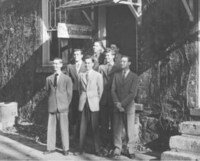Davidsonian
On March 18, 1914, the student body voted on and approved the creation of a collegiate newspaper that would report on the campus and local community events and issues. During the same month, a contest was held to decide the name of the publication. Along with entries such as “Red and Black” and “Haka-Raka,” the staff picked The Davidsonian, submitted by William H. Neal and Philip Price, both class of 1917. William Neal won the contest prize, a free subscription to the newspaper, by a coin toss.
On April Fool’s Day in 1914, the first issue of The Davidsonian was published. The first issue included stories about civic improvement in the town, election results for the literary societies, the launching of the baseball season, and a 30-minute meeting between Davidson College President William J. Martin and United States President and Davidson alumnus Woodrow Wilson. Frank W. Price, the first Editor-in-Chief of The Davidsonian, also wrote about the purpose and goals of the newspaper in the first editorial, excerpted here:
“[The Davidsonian] should be in close touch with every phase of college life and the life of the community about it. Even in a small college, life becomes more and more complex, and as the students are broken up into an increasing number of groups, there is a tendency not to look beyond the questions and the matter in which one man is directly interested. The college newspaper should give live information about every group and department of college activity, keep them acquainted with each other, and thus promote a feeling of mutual interest and encouragement. In addition, these are the things which vitally concern every student, and yet which are not well know or misunderstood.”
The Davidsonian successfully has published a volume every year since its inception in 1914, even during paper shortages in the Second World War, although it cut by half, the number of pages it produced. In addition to publishing a volume each year, the students published one volume during the summer of 1943 because so many students were on campus for summer session.
Other milestones in the life of the paper include being honored by the North Carolina Collegiate Press as the “best paper in the state” in 1924 and 1925. In 1969, Davidsonian alumni editors collected and contributed enough money to microfilm the entire Davidsonian collection in addition to leaving funds for future microfilming and preservation. Davidson College maintains one set of microfilm, while the University of North Carolina in Chapel Hill maintains the duplicate set.
The Davidsonian also has a tradition of producing spoof newspapers. Gag issues were not uncommon, such as The Saturday Evening Toast, created by the Davidsonian staff, which appeared in 1920s. On April 1, 1955, that week’s publication headlined with “Davidsonian Is Sold” and “ODK Proposes Scented, Colored Tissue Paper.”
Other variations of the newspaper’s title, such as The Davidson Outdate, The David’s Onion, The Devoidsonian, and The Davidfonian, have been published since the 1970s to indicate that the stories and articles in that particular issue were farcical.
The Yowl became a humor section of The Davidsonian in January 2004. Named for an campus publication in the 1930s, The Yowl, and its sequel, Scripts ‘N Pranks, were magazines in competition with The Davidsonian. The editorial staffs of each publication had a tradition of providing ridicule in place of constructive criticism of their competitor until the last publication of Scripts ‘N Pranks in February 1965.
On a humorous note, the December 1971 gag issue was headlined ‘Trustee Approval Final Hurdle Left for Spencer-Bevan Coeducation Plan’” (Moore). Unknown by the editors at the time, the Board of Trustees had been discussing the possibility of accepting women at Davidson College. This idea was approved barely six months after the headline appeared.
As Thomas Moore reported in the Davidson Update in April 1989, more serious stories, such as one in October 1972 “questioning Davidson’s ‘Christian Commitment’ stipulation in awarding tenure,” made contributions to Davidson’s history. Five years later, when national publications, such as The New York Times and The Washington Post publicized a “retracted job offer to Jewish professor Ron Linden, the resulting outcry from the newspaper and students led to a trustee change in policy by the end of the year” (Moore). The 1972 Davidsonian story had questioned that very stipulation five years earlier and continued to cover the controversy when it got national attention.
Throughout its existence, The Davidsonian has attempted to publish news surrounding the community with very few changes in its processes. One of the few changes that did occur was the adjustment to the appointment of the editorial staff. Previously, the Editor-in-Chief was voted into the position by the student body, but in 1992, the Media Board, made up of faculty, staff, and SGA-appointed students, decided to invoke powers given to it in the Davidson College Constitution. The students no longer would choose the editor. The Media Board would have final approval of nominations for the position (SGA minutes, February 6, 1990).
Perhaps the latest milestone in the history of The Davidsonian appeared in the April 27, 2005 issue. The editors published “The Davidsonian Code of Ethics ” to develop further the professionalism of The Davidsonian. It includes a Preamble and list of the ethical and professional responsibilities, to which it will adhere.
For more information see Around the D blog: The Davidsonian at 100.



